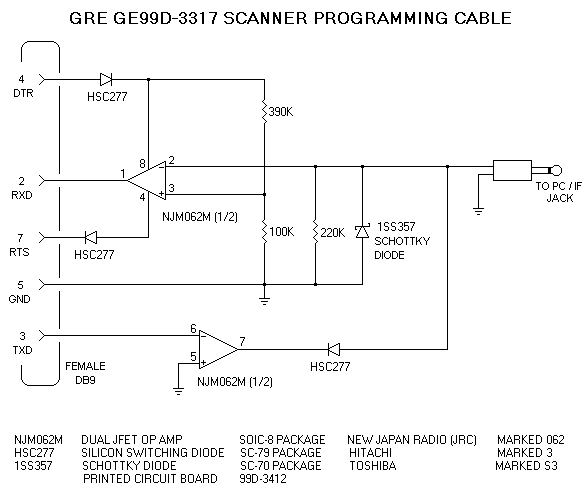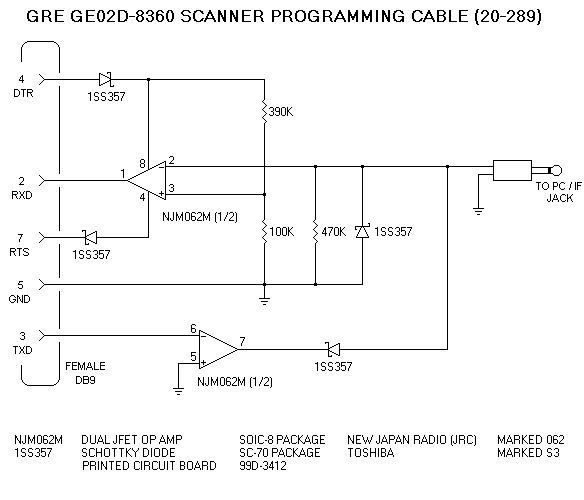
When the PRO-92 was introduced GRE sold a programming cable that was bundled with Scanner Data Manager. The cable allowed programming data to be read from the scanner and also to be written to the scanner when used with suitable software. The schematic of this cable is shown below as part number GE99D-3317. With the introduction of the PRO-96 Radio Shack began selling GRE cables with the part number GE02D-8360, catalog number 20-289. The schematic for this cable is below and a comparison of the two diagrams shows them to be very similar.


An analysis of the circuits shows a major design flaw. The op amp is a dual unit with one section used to drive the PC/IF (personal computer interface) jack on the scanner. For the PRO-92 the allowable voltage is 0 - 5 volts while the newer radios, PRO-93, PRO-95, and PRO-96, require a 0 - 3.5 volt input. The diode connected to the op amp output does not allow a positive voltage to be driven from the op amp to the radio. It does allow a low voltage (logic zero) to be sent to the radio. Since the op amp VEE supply is connected to the negative voltage from the serial port, the op amp will attempt to drive the voltage negative. The Schottky diode clamp at the PC/IF output prevents the voltage from going very far negative and effectively shorts the op amp output to ground when it tries to drive a low output voltage. The op amp is rated to put out 15 mA when the output is shorted which is far more than the serial port can provide. Oscilloscope measurements show that the serial port varies from -10 volts to -5 volts in step with the data stream due to the repetitively applied short circuit. The voltage drop across the Schottky diode measures 0.36 volts which corresponds to 15 mA on its V-I curve.
This puts unnecessary stress on the serial port and makes it likely that the weaker serial ports found in laptop computers will be unable to power the cable. It would have been far better to replace the op amp driver with a ground referenced transistor to avoid the high circulating current.
A few other comparatively minor concerns were also noted in the circuit analysis. The op amp is rated to drive a 10K Ohm load while the serial port imposes a 4.3K Ohm load. Its output stage is barely able to drive the serial port to full output levels. Bypass capacitors of 0.1uF should be added to the VCC and VEE terminals of the op amp as a matter of standard engineering practice. Finally, the 390K - 100K resistor divider that sets the switching threshold for the upper op amp will allow wide threshold variability in proportion to the serial port voltage from the DTR pin. It would have been better to use a pair of forward biased diodes to set the threshold for better stability.
The poor performance of the GRE cables was unexpected and their usage is not recommended. Better results can be had by constructing a cable from plans available on the internet or by buying a third party cable designed for the PRO- series scanners.